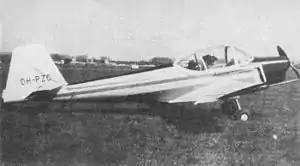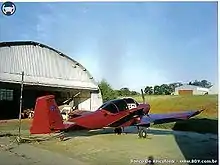PZL-102 Kos
The PZL-102 Kos (blackbird) is a Polish two-seat touring and training monoplane designed and built by PZL.
| PZL-102 Kos | |
|---|---|
 | |
| Role | Two-seat touring/training monoplane |
| Manufacturer | PZL |
| First flight | 23 May 1958 |
| Introduction | 1959 |
| Produced | 1959-1962 |
| Number built | 10 |
Development
First flown on 21 May 1958 by Mieczysław Miłosz the PZL-102 was designed as a semi-aerobatic two-seat light monoplane and was later given the name Kos. The Kos was an all-metal low-wing cantilever monoplane with fabric tail control surfaces. It had a fixed tailwheel landing gear and the prototype had a nose-mounted 65 hp (48 kW) Narkiewicz WN-1 flat-four engine. The Kos had an enclosed cockpit for two side-by-side. After a number of prototypes the production aircraft (designated PZL-102B) first flew in October 1959, with Continental C90 engine and changed wing construction. Only short series was produced, because it needed imported engine.
Operational history
Between 13 May and 8 June 1960 Antoni Szymański made 9000 km commercial flight on PZL-102B on route Warsaw - Vienna - Geneva - Reims - London - Luxembourg - Berlin - Warsaw.
Seven aircraft were sold abroad. Austrian aircraft were operated for agrospraying purposes. Tank filled with chemical agent was placed on the passenger seat.
One PZL-102 has been restored to airworthy condition (markings SP-EFA).

Variants
- PZL-102A
- Prototypes
- PZL-102B
- Production variant with Continental C90 engine.
There is another PZL 102B restored in South Africa, based at Jack Taylor Airfield Krugersdorp, and one more in Brazil (PT-BGP)
Specifications (PZL-102B)
Data from Jane's All the World's Aircraft 1962-63,[1] The Illustrated Encyclopedia of Aircraft[2]
General characteristics
- Crew: 2
- Length: 6.97 m (22 ft 10 in)
- Wingspan: 8.49 m (27 ft 10 in)
- Height: 1.88 m (6 ft 2 in)
- Wing area: 11.02 m2 (118.6 sq ft)
- Airfoil: NACA 43012A[3]
- Empty weight: 418 kg (922 lb)
- Max takeoff weight: 630 kg (1,389 lb)
- Fuel capacity: 75 l (19.8 US gal; 16.5 imp gal)
- Powerplant: 1 × Continental C90-12F 4-cylinder air-cooled horizontally-opposed piston engine, 71 kW (95 hp)
- Propellers: 2-bladed fixed-pitch wooden propeller, 1.8 m (5 ft 11 in) diameter
Performance
- Maximum speed: 193 km/h (120 mph, 104 kn)
- Cruise speed: 174 km/h (108 mph, 94 kn)
- Stall speed: 69 km/h (43 mph, 37 kn) with flaps down
- Never exceed speed: 300 km/h (190 mph, 160 kn)
- Range: 640 km (400 mi, 350 nmi) at 135 km/h (84 mph; 73 kn)
- Service ceiling: 3,800 m (12,500 ft)
- Rate of climb: 3.5 m/s (690 ft/min)
- Wing loading: 57.2 kg/m2 (11.7 lb/sq ft)
- Power/mass: 0.1126 kW/kg (0.0685 hp/lb)
- Take-off run: 460 m (1,509 ft)
- Take-off distance to 15 m (49 ft): 1,300 m (4,265 ft)
- Landing distance from 15 m (49 ft): 1,100 m (3,609 ft)
References
- Taylor, John W.R., ed. (1962). Jane's All the World's Aircraft 1962-63. London: Sampson Low, Marston & Co.
- The Illustrated Encyclopedia of Aircraft (Part Work 1982-1985). Orbis Publishing. p. 2675.
- Lednicer, David. "The Incomplete Guide to Airfoil Usage". m-selig.ae.illinois.edu. Retrieved 16 April 2019.
Further reading
- Taylor, Michael J. H. (1989). Jane's Encyclopedia of Aviation. London: Studio Editions.
